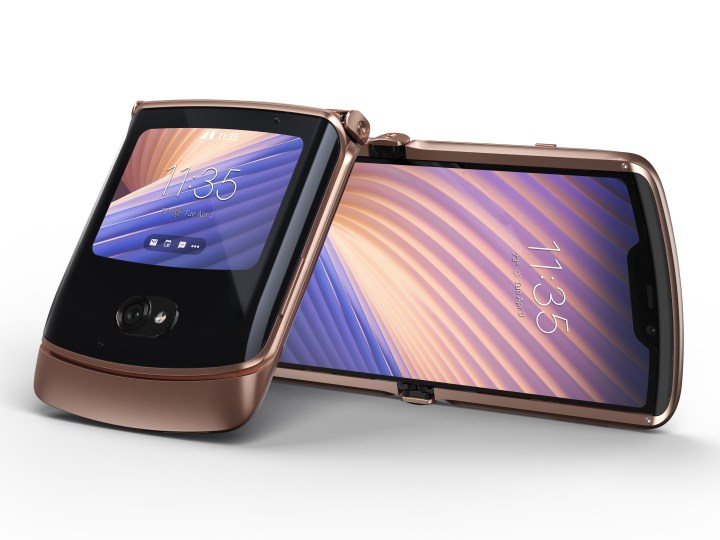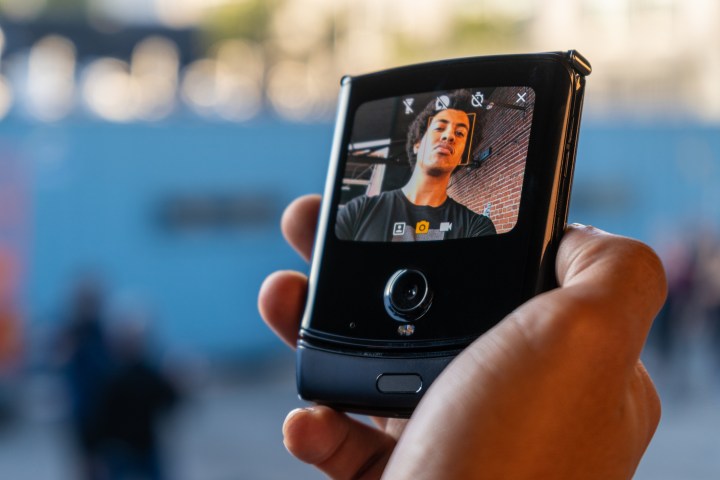Following the release of the Motorola Razr last year, Motorola has announced the launch of the new Motorola Razr 2020 (also known as the Motorola Razr 5G in the U.K.), which should be hitting shelves in the U.S. sometime this fall. Unlike the Motorola Razr 2019 — which was only available on Verizon — the new Razr will be available across all sub-6 5G networks, with a separate version for Verizon customers designed to work with its sub-6 and mmWave frequencies.
The new Razr certainly looks the part, with its 3D curved Gorilla Glass, aluminum frame, and streamlined chin — and either of these phones would make a great alternative to the Samsung Galaxy Z Flip if you’re looking for a folding phone. But how does the new handset compare to the first-generation Razr?
To help you decide which is the Razr for you, we’ve compared the two devices across six core categories. By taking a closer look at both of these amazing devices, you should be able to work out which one is right for you.
Specs
| Motorola Razr (2019) | Motorola Razr (2020) | |
| Size | Folded:
72 x 94 x 14mm (6.77 x 2.83 x 0.27 inches) Open: 72 x 172 x 6.9mm (3.7 x 2.83 x 0.55 inches) |
Folded:
91.7 x 72.6 x 16mm (3.6 x 2.86 x 0.63 inches) Open: 169.2 x 72.6 x 7.9mm (6.66 x 2.86 x 0.31 inches)
|
| Weight | 205 grams (7.2 ounces) | 192 grams (6.77 ounces) |
| Screen size | Interior:
6.2-inch OLED Exterior: 2.7 inch OLED |
Interior:
6.2-inch OLED Exterior: 2.7-inch OLED |
| Screen resolution | Interior:
2142 x 876 pixels, 21:9 ratio, (373 pixels per inch) Exterior: 800 x 600 pixels, 4:3 ratio |
Interior:
2142 x 876 pixels, 21:9 ratio (373 ppi) Exterior: 800 x 600 pixels, 4:3 ratio |
| Operating system | Android 10 | Android 10 |
| Storage | 128GB | 256GB |
| MicroSD card slot | No | No |
| Tap-to-pay services | Google Pay, Samsung Pay | Google Pay |
| Processor | Qualcomm Snapdragon 710 | Qualcomm Snapdragon 765G Adreno 620 GPU |
| RAM | 6GB | 8GB |
| Camera | Outer camera: 16-megapixel
Inner camera: 5MP |
Outer camera: 48MP
Inner camera: 20MP |
| Video | 4K at 30 frames per second, 1080p at 30 fps, 720p at 30 fps
Gyro-EIS |
4K at 30 fps, 1080p at 120 fps, 720p at 240 fps
Time-lapse video, Hyperlapse, EIS |
| Bluetooth version | 5.0 | 5.0 |
| Ports | USB 3.0, USB-C | USB 3.0, USB-C |
| Fingerprint sensor | Yes | Yes |
| Water resistance | Splashproof with water-resistant nano-coating | Water-repellent design |
| Battery | 2,510mAh
15W TurboPower charging |
2,800mAh
15W TurboPower charging |
| App marketplace | Google Play Store | Google Play Store |
| Network support | Verizon only | All carriers |
| Colors | Noir Black, Blush Gold | Polished Graphite, Liquid Mercury, Blush Gold |
| Prices | $1,500 | $1,399 |
| Buy from | Verizon, Walmart, Motorola | Coming this Fall to Best Buy, B&H Photo, Amazon, Motorola, AT&T, T-Mobile, and Verizon |
| Review score | Hands-on review | News |
Design, display, and durability

For those unfamiliar with the first-gen Razr phone, telling the two apart can be a challenge. However, there are some subtle but very important differences. The Motorola Razr 2019’s polycarbonate, stippled exterior is not only tacky to the touch, it’s also a magnet for fingerprints — hardly ideal when the capacitive fingerprint sensor is housed in the chunky chin area at the bottom of the phone. In contrast, the Motorola Razr 2020 boasts a redesigned camera module with a tapered chin, thanks in part to the relocated fingerprint sensor, which now resides on the back of the phone. Speaking of the back of the phone, the 2020 model is clad in 3D curved Gorilla Glass with an aluminum frame. The entire phone is also splash-resistant — as opposed to the Razr 2019, which only features a splash-resistant nano-coating on the screen.
But perhaps the main change to the new Razr comes with its folding mechanism. The hinge on the original model came under fire for being loud, creaky, and tough to open and close, with many users complaining its stiffness made it nearly impossible to flip the phone open with a thumb. The last thing you want when opening your phone is to worry about scratching the screen or, worse, dropping your phone. There were also complaints about the visible gap when the phone was folded, which let dust and debris gather on the screen. It looks like Motorola took these comments on board for the Razr 2020, which, according to Motorola, has an “industry-first, patent-protected zero-gap hinge” that folds fully flush thanks to its teardrop curvature, keeping the display safe. Motorola also promises the hinge is robust, and it’s been tested to withstand over 200,000 folds — which should last the average user five years by their estimations.
All things considered, the improved folding mechanism and hinge, combined with the redesigned shape, just put the Motorola Razr 2020 in the lead.
Winner: Motorola Razr (2020)
Performance, battery life, and charging

When you’re dropping $1,500 on the Motorola Razr 2019, you’d expect a flagship Qualcomm chipset. Sadly, the first-gen Razr disappoints with its Snapdragon 710 processor, which is fast but still falls short of expectations for the price. The Motorola Razr 2020, in comparison, has the 765G chipset, which is faster and enables low and mid-band 5G connectivity. This is the same processor you’ll find in the much cheaper OnePlus Nord and LG Velvet. That said, the Motorola Razr 2020’s chipset should pack enough power for all but the most demanding users playing the latest mobile games, and, for the price, it’s definitely our pick of the pair.
The Razr 2019 packs 6GB of RAM, with the Razr 2020 providing 8GB. It’s worth noting that neither Razr has expandable storage, as there’s no microSD card slot — which could influence your purchasing decision. The Razr 2019 provides 128GB of internal storage, while the newest Razr packs double this, giving you 256GB to play with.
When it comes to the battery, neither Razr performs particularly well — after all, the compact size of the phone calls for a smaller battery. However, the Razr 2020 has a slight advantage. It’s furnished with a slightly beefier 2,800mAh battery, the same as the Google Pixel 4, while the Razr 2019 is powered by a 2,510mAh cell — that’s a smaller battery than the Samsung Galaxy S10 (3,400mAh). Motorola promises all-day battery life without giving away much more detail, and in our tests, we found we could get a full day of medium usage — especially if you use the front screen for tasks like replying to texts, making calls, and accessing important apps on the go. Android 10’s Quick View functionality makes this easier, and using the front screen instead of flipping the phone open makes a huge difference to battery life with both the 2019 and 2020 Razr phones. Unfortunately, heavy users may only get around six hours of juice from the Razr 2019 battery, whereas the 2,800mAh battery of the Razr 2020 should extend this slightly, depending on how often you open the phone.
Given the difference in battery life, RAM, and internal storage, we’re going to give the Motorola Razr 2020 the victory here.
Winner: Motorola Razr (2020)
Camera

You don’t need to own a Razr to know Motorola is unlikely to win any prizes for its imaging technology — but the Motorola Razr 2019’s 16MP camera was a bit of a letdown. Many budget phones capture better shots than the Razr 2019, and when you consider the phone’s premium price, it’s easy to understand the disappointment. The good news is the camera has seen the most improvements when it comes to the new Razr. Boasting a 48MP main camera — which works great in low light — and a 20MP interior camera, the Motorola Razr 2020 also has laser autofocus and optical image stabilization to ensure you snap the perfect shot. Taking the best selfies for Instagram is a breeze, too, as the exterior 48MP shooter works as the front camera when you close the phone and use the Quick View screen as your viewfinder. We’d stick to using the 20MP interior camera for video calls or those less-important selfies.
Video recording on the Motorola Razr 2020 sees the phone come out ahead of the first-gen Razr, too. While the older Razr enables shooting video at 4K resolution at 30 fps (and 1080p at 30 fps), the new Razr 2020 lets you shoot 1080p resolution at 120 fps and 720p at 240 fps, so it can be relied upon to capture some impressive film footage.
It’s clear the camera has been the main focus for improvements in the new Razr, making it our well-deserved winner in this category.
Winner: Motorola Razr (2020)
Software and updates

Both phones come with Android 10, and with the recent arrival of Android 11, we expect the new Motorola Razr 2020 will be updated at some point — most likely, the Motorola Razr 2019 will be, too, although if you’re looking for a future-proof device, the new Razr 2020 is our pick. The Quick View display on the new Motorola Razr 2020 has received a substantial update — now, as well as reading notifications and using the screen as a camera viewfinder, you can make calls, run any app, reply to messages, and carry out a whole range of quick tasks without opening the phone. It’s worth noting that some of these improvements hit the Motorola Razr 2019, too, as part of the Android 10 update.
Winner: Tie
Special features

The Motorola Razr 2020 is a 5G phone, currently available on 5G network bands with both AT&T and T-Mobile (but only on the slower and more widespread sub-6 5G network). A Verizon-specific model is also likely to be available. The Motorola Razr 2019 doesn’t support 5G, which makes the new Razr our pick for a future-proof phone.
There are a couple of differences when it comes to water resistance too. Although neither phone is IP68 rated — so no taking them in the tub — the Motorola Razr 2020 does come out ahead, as the entire phone is splashproof. The earlier model features a splashproof nano-coating on the screen only.
We’d opt for the Motorola Razr 2020, thanks to its 5G connectivity and splashproof coating, so it’s our winner for this category.
Winner: Motorola Razr 2020
Price and availability
The Motorola Razr 2019 starts at $1,500. It’s available on Verizon only and from such retailers as Walmart and Motorola — right now you can pick it up for the discounted price of $1,000 at Motorola.
Prices for the Motorola Razr 2020 start at $1,399. On launch, it should be available at Best Buy, B&H Photo, Amazon, and Motorola, as well as T-Mobile, AT&T, and Verizon.
Overall winner: Motorola Razr (2020)
There are some significant differences between these two smartphones, from the improved camera to the more powerful processor — and the Motorola Razr 2020 is the clear winner here. With its new, improved hinge, 5G connectivity, and bigger battery, it’s future-proof and it will cost you less than the Razr 2019 to boot.
That’s not to say that the Motorola Razr 2019 isn’t worth your money. It’s still a solid, reliable flip phone — although the Samsung Galaxy Z Flip boasts a bigger battery, more powerful processor, and a better camera. In terms of value for money, the Motorola Razr 2020 still beats the Razr 2019 to the finish line.
Editors' Recommendations
- Motorola’s next folding phone just leaked. Here’s what it looks like
- The best Motorola phones in 2024: which one should you buy?
- If you have one of these Motorola phones, you’re getting a big Android update
- Motorola’s newest folding phone is cheaper than the iPhone 15
- Motorola just launched 3 new Android phones, and they look incredible



